- in United States
- within Wealth Management and International Law topic(s)
The beauty and consumer products industries have seen a rise in so-called "dupes" – products that closely imitate the look and feel of well-known, often more expensive brands. The surge in "dupes" in the marketplace has led to a wave of legal disputes, as brand owners seek to protect their intellectual property from what they view as unfair exploitation. At the heart of the debate lies the question: when does inspiration cross the line into infringement?
The legal landscape surrounding dupes is nuanced and evolving. Courts must balance the value of competition and affordability for consumers with the rights of brands to safeguard their market position and reputation. Like parody, dupes are oxymoronic: they, by name, duplicate an existing product, yet often call attention to their own duplicity. As the purpose of the Lanham Act is to ensure that consumers are not confused when making purchasing decisions, whether a product touted as a "dupe" is considered an infringement has sparked a series of legal disputes as established brands seek to defend their intellectual property and the junior user claims that there is no lability because consumers understand that they are not purchasing the senior user's product. This article provides a high level overview of some recent cases addressing dupes and then sets forth some takeaway points for industry players on both sides of the aisle.
Key Case Study: Benefit Cosmetics v. e.l.f. Cosmetics
In Benefit Cosmetics LLC v. e.l.f. Cosmetics, Inc., Benefit alleged that e.l.f.'s LASH 'N ROLL mascara infringed on its ROLLER LASH trademark and mascara packaging trade dress. See Benefit Cosmetics LLC v. E.L.F. Cosmetics, Inc., No. 23-cv-00861, 2024 WL 5135604 (N.D. Cal. 2024).
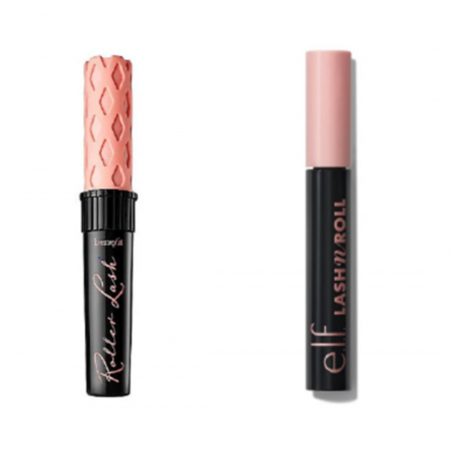
Source: Pl.'s Compl. ¶ 48, ECF No. 1, Benefit Cosmetics LLC v. E.L.F.. Cosmetics, Inc., Case No. 23-cv-00861.
While both parties' products featured similar black-pink packaging and names, the court ultimately found no likelihood of confusion. Some factors given weight in this decision were:
- Intent: Internal correspondence at e.l.f. revealed no intent to deceive consumers, but rather an acknowledgment of inspiration and an aim to "cue" customers.
- Marketing & Sales Channels: The products occupied distinct market positions: Benefit in prestige outlets and e.l.f. in mass-market retailers. Even when sold in the same stores, the retailers shelved the mascara separately.
- Price Difference: A significant price gap ($29 vs. $6) further reduced the risk of consumer confusion.
- Use of House Marks: Prominent branding by e.l.f. helped distinguish the products.
- Actual Confusion Evidence: Survey data indicated only a 5% net confusion rate, insufficient to establish infringement. The survey, alongside the fact that both marks have been in coexistence for two years, cut in favor of e.l.f.
Following a bench trial, the court concluded that, despite surface similarities, the combination of clear branding, distinct channels, and significant price differences signaled to consumers that the products were unrelated and dispelled the risk of consumer confusion. Benefit Cosmetics, 2024 WL 5135604, at *17.
Other "Dupe" Cases
Additional cases further illustrate how brands are attempting to enforce their rights against "dupes" in the beauty and consumer goods industries. The following are pending matters that highlight both the complexity and the ever-adapting strategies of brands and newcomers.
Appollo Healthcare Corp. v. Sol de Janeiro USA, Inc. et al.
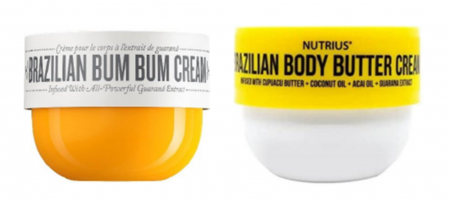
Source: Pl.'s Compl., ECF No. 1-1, 2–3, Apollo Healthcare Corp. v. Sol de Janeiro USA Inc. et al., Case No. 22-cv-07719.
Allegations: In response to Apollo's suit for declaratory judgment, Sol de Janeiro alleges that Apollo's body butter product infringes its Brazilian Bum Bum Cream's trade dress and trademark rights. See Apollo Healthcare Corp. v. Sol de Janeiro USA Inc., No. 22 CIV-7719 (LLS), 2024 WL 4555822, at *2 (S.D.N.Y. Oct. 23, 2024).
Legal Arguments: Sol de Janeiro argues that Apollo intentionally copied nearly every element of the trade dress of its "cult-favorite" Bum Bum Cream—including its rounded bottom, overhanging lid, black lettering, and calling to the attention of its consumers the Guaraná extract ingredient—in order to deceive consumers into thinking its body butter was created or sponsored by Sol de Janeiro. Def.'s Ans. To Second Amended Compl. And Amended Counterclaims, ¶¶ 159–66, ECF No. 67.
Key issues: The court left it for a jury to decide whether there is a likelihood of confusion between the two products. Apollo, 2024 WL 4555822, at *6. Questions for a jury will include: whether the places where the products are sold—one at Sephora, the other at Costco—are sufficient to differentiate them, whether consumers have actually been confused by the similarities, and whether there is sufficient evidence to show that Apollo's product development team intended to emulate and capitalize on Sol de Janeiro's product. Id. at 6–8.
Sol De Janeiro USA, Inc. et al. v. MCoBeauty Pty Ltd et al.
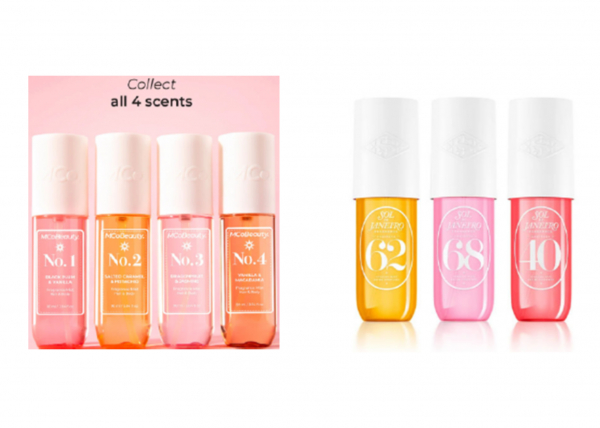
Source: Pl.'s Compl. ¶ 84, ECF No. 1, Sol de Janeiro USA, Inc. v. MCoBeauty Pty Ltd et al., Case No. 24-cv-08862.
Allegations: Sol De Janeiro also accuses the Australian-based MCoBeauty of infringing on the trade dress of its popular "Cheirosa Body Mists" line. Central to the complaint is the claim that MCoBeauty's products, which are marketed as direct "dupes" of the Cheirosa collection, amount to false advertising and violate New York's unfair competition laws. Sol de Janeiro USA, Inc. v. MCoBeauty Pty Lt et al., No. 24-cv-08862 (S.D.N.Y. Compl. filed Nov. 11, 2024).
Legal Arguments: The plaintiff asserts that the presentation, packaging, and promotional language employed by MCoBeauty closely mimic the distinctive visual cues and reputation of the Cheirosa products, with the intent, and effect, of capitalizing on Sol De Janeiro's brand equity.
Key Issues: At stake are the boundaries of permissible comparative marketing, the sufficiency of disclaimers or source-identification, and the weight to be given to evidence of actual confusion or intent to emulate.
Aramara Beauty LLC d/b/a Glow Recipe v. MCO Beauty PTY Limited et al
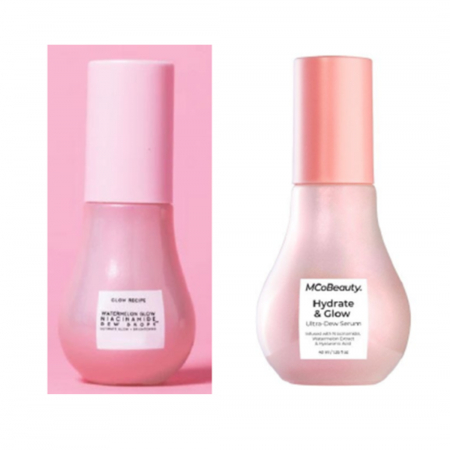
Source: Pl.'s Compl. ¶ 21, ECF No. 1, Aramara Beauty, LLC v. MCO Beauty Pty Ltd, Case No. 25-cv-04808.
Allegations: Glow Recipe alleged that MCoBeauty infringed on the trade dress of their WATERMELON GLOW NIACINAMIDE DEW DROPS serum and made claims of false designation of origin and false descriptions. Of particular significance is the claim that MCoBeauty has publicly referred to the contested items as "dupés," which, according to Glow Recipe, demonstrates an awareness of post-sale confusion and an intent to market their products as intentional imitations of the original. Aramara Beauty, LLC v. MCO Beauty Pty Ltd, No. 25-cv-04808 (S.D.N.Y. Compl. filed June 6, 2025)
Legal Arguments: Glow Recipe advances claims under New York trademark infringement statutes and unfair competition laws. The references to the products as "dupés" and the resulting confusion are positioned as central evidence supporting the claims of trademark infringement and unfair competition, reflecting a broader pattern of alleged unfair practices that pervade the related cases.
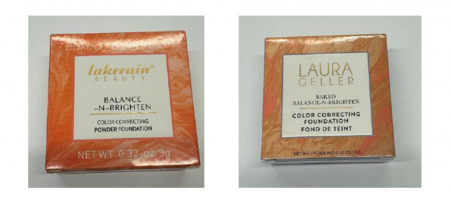
AS Beauty Group LLC v. Guangzhou Aolimei Cosmetics Co., Ltd.:
Source: Pl.'s Compl. ¶ 18, ECF No. 1, AS Beauty Group LLC v. Guangzhou Aolimei Cosmetics Co., Ltd., Case No. 24-cv-08461.
AS Beauty Group alleges that Guangzhou Aolimei Cosmetics infringed on the trade dress and trademark of their BALANCE-N-BRIGHTEN and BRONZE-N-BRIGHTEN (not pictured) products, bringing unfair competition claims and alleging violations of NY Antidilution law. AS Beauty Group LLC v. Guangzhou Aolimei Cosmetics Co., Ltd., No. 24-CV-08461 (S.D.N.Y. Compl. filed Nov. 6, 2024).
Tapestry, Inc. et al v. Last Brand, Inc. et al: Tapestry Inc. (Coach) alleges that Last Brand (Quince) infringed on the trade dress and trademark of their ROGUE and SOHO FLAP bags, bringing unfair competition claims under CA law. Tapestry Inc. v. Last Brand, Inc., No. 25-cv-03082 (N.D. Cal. Compl. filed April 4, 2025).
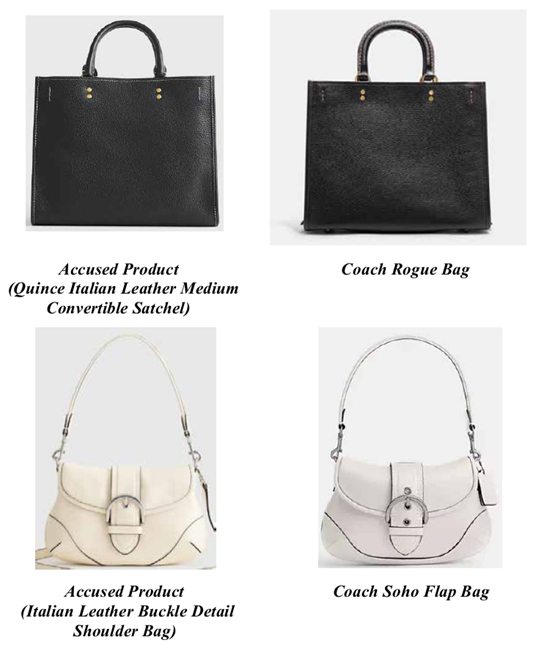
Source: Pl.'s Compl. ¶ 15, ECF No. 1, Tapestry Inc. v. Last Brand, Inc., Case No. 25-cv-03082.
Deckers Outdoor Corporation v. Last Brand, Inc.: Deckers alleges that Last Brand (Quince) infringes on the trade dress of their UGG Classic Ultra Mini and brought unfair competition claims under California law, along with patent infringement claims. Deckers Outdoor Corp. v. Last Brand, Inc., No. 23-cv-04850 (N.D. Cal. Compl. filed June 12, 2023).

Source: Pl.'s Amended Compl. ¶ 16, 21, ECF No. 25, Deckers Outdoor Corp. v. Last Brand, Inc., Case No. 23-CV-04850.
Deckers Outdoor Corporation v. Costco Wholesale Corporation et al: Deckers claimed that Costco infringed on the trade dress of their UGG Tasman slipper and brought unfair competition claims under California law. Deckers Outdoor Corp. v. Costco Wholesale Corp., No. 25-cv-04174 (C.D. Cal. Compl. filed May 5, 2025).

Source: Pl.'s Amended Compl. ¶ 21, ECF No. 23, Deckers Outdoor Corp. v. Costco Wholesale Corp., Case No. 25-cv-04174.
Mondelez International, Inc. et al v. Aldi Inc: Mondelez claimed that Aldi infringed on the trade dress of several products, including Oreo, Wheat Thins, Nutter Butter, Chips Ahoy!, Nilla Wafers, Ritz, and Premium Saltine Crackers. They also brought claims of trademark dilution under state and federal law, as well as unfair competition under Illinois law. Mondelez Intl., Inc. v. Intercontinental Great Brands LLC, No. 25-cv-05905 (N.D. Ill. 2025 Compl. filed May 27, 2025).
.jpg)
Source: Pl.'s Compl. ¶ 9, ECF No. 1, Mondelez Intl., Inc. v. Intercontinental Great Brands LLC, Case No. 25-cv-05905.
Key Takeaways
As shown, the line between inspiration and infringement is defined by intent in product development and the realities of the marketplace. These "dupes" cases show that mere visual similarity is no longer sufficient to establish infringement. Instead, courts are examining the motives behind product design, how and where consumers encounter the products, and the actual perceptions of consumers.
Lessons from the ongoing "dupes" cases is that clear comparative advertising, use of distinctive house marks, and well-defined sales channels can lead to a finding that there is not a likelihood of consumer confusion. Conversely, evidence of intent to deceive or exploit confusion can tip the scales toward the finding of infringement, regardless of surface-level differences. As courts continue to address the ways to measure trade dress and trademark protection in the context of "dupes," senior and junior brands must carefully navigate the nuanced interplay between competition and imitation.
Dyan Finguerra-DuCharme is the Co-Chair of the Intellectual Property Department at Pryor Cashman LLP and the Co-Chair of the Fashion Law Committee at the NYIPLA. Dyan thanks summer associate Anton Lopa for the excellent research he conducted and Claire Bleecker, a first year associate at the firm who also contributed to this article.
This article first appeared in the October 23, 2025, edition of the "New York Law Journal" © 2025 ALM Global Properties, LLC. All rights reserved.
The content of this article is intended to provide a general guide to the subject matter. Specialist advice should be sought about your specific circumstances.

